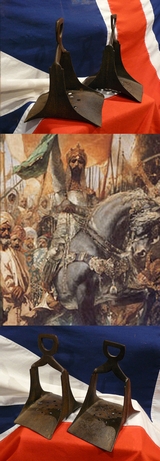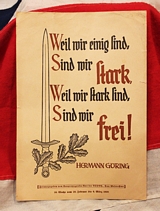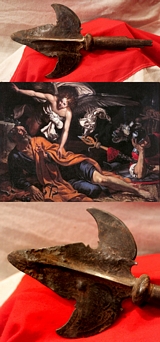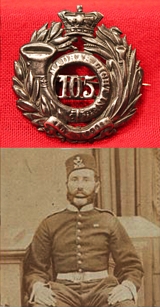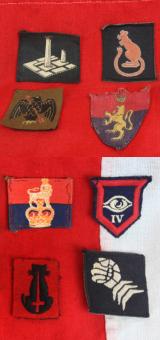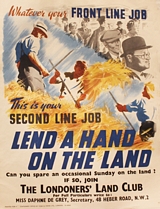A Fascinating Most Rare Original Election Propaganda Poster of a Post WW1 German Political Party That Was Absorbed Into The Nazi NSDAP German National People’s Party. Designed by Richard Müller, Chemnitz.
A Reichstag election poster of the German National People's Party.
Wohin die fahrt?
nach nationaler einheit u freiheit
wahlt deutschnational
Where are you going?
according to national unity and freedom
elect a German national
The German National People's Party (German: Deutschnationale Volkspartei, DNVP) was a national-conservative party in Germany during the Weimar Republic. Before the rise of the Nazi Party, it was the major conservative and nationalist party in Weimar Germany. It was an alliance of nationalists, reactionary monarchists, völkisch and antisemitic elements supported by the Pan-German League After 1929, the DNVP co-operated with the socialist Nazis, joining forces in the Harzburg Front of 1931, forming coalition governments in some states and finally supporting Hitler's appointment as Chancellor (Reichskanzler) in January 1933. Initially, the DNVP had a number of ministers in Hitler's government, several prominent Nazis began their careers in the DNVP., but the party quickly lost influence and eventually dissolved itself in June 1933, giving way to the Nazis' single-party dictatorship, the majority of its former members joining the Nazi party. The Nazis allowed the remaining former DNVP members in the Reichstag, the civil service, and the police to continue with their jobs and left the rest of the party membership generally in peace
During the Second World War, several prominent former DNVP members, such as Carl Friedrich Goerdeler, were involved in the German resistance against the Nazis and took part in the 20 July assassination plot against Hitler in 1944. Approx size A4. read more
220.00 GBP
SAVE £650 A Rare Pair of Antique Ottoman Empire Iron Stirrups
A pair of antique 17th to 18th century Turkish Ottoman Empire russet iron stirrups of characteristic form, with broad arch treads. All steel construction in the early style that goes back to the medieval period. One picture in the gallery shows Fatih Sultan Mehmet II [using his identical stirrups] entering Constantinople, after his conquest, in 1453. The stirrup took time to appear on the scene. The saddle itself was a relative latecomer in the history of riding ? Alexander the Great, for example, conquered his empire astride some simple pieces of cloth. Saddles with saddle trees, which made stirrups possible, are said to have first appeared in Central Asia around the time of Jesus birth. And after having initially taken the form of a buckle, notably in India,?the first stirrups for both feet reinforcing the rider's balance seem to have arisen around the year 100 in the Kushan Empire (encompassing parts of Afghanistan, modern-day Pakistan and northern India) before spreading to northern China in the 3rd century and the western steppes of Iran in the 6th century. Hundreds of years later around 700 years after Jesus Christ stirrups reached Western Europe, spreading throughout the society around the 9th century. Several routes are possible when explaining their arrival in the region, and expert opinion is divided on the subject. Some say they were brought by the Huns; others affirm that they were introduced by Persians to Arabs, then Arabs to Byzantines; still others believe that Arabs imported them into Europe via southern Spain and the south of France. Whatever the case, the earliest representations of stirrups appear on a chess set piece offered to Charlemagne by the caliph Haroun al-Rachid (who died in 809), then in Spanish documents in the first part of the 9th century. read more
295.00 GBP
Reich Marshall Herman Goering Small Propaganda Poster With Luftwaffe Sword
In very good condition for age. Rarely surviving piece from the the pre war Germany.Weil wir einig sind, sind wir stark, weil wir stark sind, sind wir frei. ... Hermann Goring", " Because We Are United We Are Strong, Because We Are Strong We Are Free" 28th of February to 6th Martch 1938. [weekly slogans of the National Socialist German Workers' Party]. Another original copy of it is in the George C Marshall Foundation library During World War II, Marshall as Army Chief of Staff (1939-1945) was the most important military figure in the U.S. military establishment and of great significance in maintaining the Anglo-American coalition. After the war, he was named special ambassador to China (1945-1947), Secretary of State (1947-1949), President of the American Red Cross (1949-1950), and Secretary of Defense (1950-1951). In 1953 he was awarded the Nobel Peace Prize for his role in proposing, encouraging legislative action, and supporting the European Recovery Program (known as the Marshall Plan). For nearly 20 years he was a major U.S. leader, militarily, politically and morally, and he is still widely admired today. read more
245.00 GBP
A Battle Worn Original Early 17th Century Italian Partizan Polearm Head
Steel three prong partizan decorated with birds on a floral background from the 1620's. Battle damaged and a fabulous artifact of 17th century warfare. With later haft [not shown] A partizan (also partisan) is a type of polearm that was used in Europe in the Middle Ages. It consisted of a spearhead mounted on a long shaft, usually wooden, with protrusions on the sides which aided in parrying sword thrusts. From the era of the Italian Wars of Castro. They were a series of conflicts during the mid-17th century revolving around the ancient city of Castro (located in present-day Lazio, Italy), which eventually resulted in the city's destruction on 2 September 1649. The conflict was a result of a power struggle between the papacy ? represented by members of two deeply entrenched Roman families and their popes, the Barberini and Pope Urban VIII and the Pamphili and Pope Innocent X ? and the Farnese dukes of Parma, who controlled Castro and its surrounding territories as the Duchy of Castro. We do have its polearm 70 inches long overall, 12.5 head incl. side straps read more
675.00 GBP
A Most Rare Victorian, Anglo Indian, British Raj, Silver 105th (Madras Light Infantry) Officer Glengarry Badge
From the British Raj, one of the most desirable eras of collectable militaria of Anglo Indian history. Pre 1881 Silver coiled bugle horn couched within crowned sprays of laurel and palm, the horn with central floreate numerals 105, on the curl of the horn Madras Light Infty.. A scroll on the junction of the leaf sprays Cede Nullis. Sealed in 1876. Became the King's Own Yorkshire Light Infantry in 1881 The 105th Regiment of Foot (Madras Light Infantry) was an infantry regiment of the British Army from 1862 to 1881, when it was amalgamated into The King's Own Light Infantry (South Yorkshire Regiment).
The regiment was originally raised by the Honourable East India Company in 1839 as the 2nd Madras (European) Regiment, redesignated the 2nd Madras (European) Light Infantry in 1842, and served in the Indian Mutiny of 1857. As with all other "European" units of the Company, they were placed under the command of the Crown in 1858, and formally moved into the British Army in 1862, ranked as the 105th Foot.
As part of the Childers Reforms in 1881, the regiment was amalgamated with the 51st (the 2nd Yorkshire West Riding) or King's Own Light Infantry Regiment to form The King's Own Light Infantry (South Yorkshire Regiment). read more
295.00 GBP
Original Uniform Removed British Formation Badges 1939-1945 & King George VIth
An embroidered cloth shoulder title for the Prince of Wales's Own Regiment of Yorkshire, comprising a base of scarlet wool cut in an arc and embroidered on obverse with the title of the regiment "PRINCE OF WALES'S OWN YORKSHIRE" in white thread, and 5 formation badges, including the 4th Guards Armoured. Formation signs were first used by the British Army in WW1 in order to provide an easy method of visual identification of the various units. They were worn on the upper sleeve in pairs, on epaulets, on head gear, painted on unit vehicles, and used on road signs. It was also quickly found that the signs created a morale boosting esprit de corps as each unit became proud of its own symbol. After WW1 the use of formation signs was discontinued, they were reintroduced at the outbreak of WW2.Divisional Signs were reintroduced early in 1940, but instructions were given in 1941 for all formation signs to be referred to as Formation Badges; the official American designation is Shoulder Sleeve Insignia. Formation badges were worn on the sleeves of uniforms except on greatcoats; in battledress, one inch below the regimental or corps shoulder title, and immediately above the arm of service strip. These were narrow two inch strips, introduced in the autumn of 1940, which gave the soldier's arm of service when wearing a steel helmet, or no cap or other distinguishing badges. Infantry battalions wore one, two, or three red strips one below the other, as in the above illustration, to indicate the brigade to which they belonged as shown here.
In tropical kit areas, such as the Middle East and Far East, the formation badges were often worn affixed to the sleeves of Kahki Drill jackets by means of press studs to facilitate laundering, or even worn stitched onto slip-on epaulettes for wearing on the shoulders of K.D, shirts; this was also the method used in the hot summer months in Italy.
On all vehicles, formation badges were stencilled in colour on the forward and rear mudguards, or on the tailboard of trucks; on jeeps the badge appeared on the body below the windscreen on the driver's side.
Officially all formation badges, and other identifying insignia such as regimental titles, were to be removed before going into battle; however, photographic evidence clearly shows that every degree of obedience to this was to be seen in Normandy, and to some extent in Italy, from completely stripped sleeve and vehicle insignia to total disregard of the order. Guards 4th armoured. london district southern commanded
read more
120.00 GBP
Original Uniform Removed 8 British Formation Badges 1939-1945 & King George VIth
Formation signs were first used by the British Army in WW1 in order to provide an easy method of visual identification of the various units. They were worn on the upper sleeve in pairs, on epaulets, on head gear, painted on unit vehicles, and used on road signs. It was also quickly found that the signs created a morale boosting esprit de corps as each unit became proud of its own symbol. After WW1 the use of formation signs was discontinued, they were reintroduced at the outbreak of WW2.Divisional Signs were reintroduced early in 1940, but instructions were given in 1941 for all formation signs to be referred to as Formation Badges; the official American designation is Shoulder Sleeve Insignia. Formation badges were worn on the sleeves of uniforms except on greatcoats; in battledress, one inch below the regimental or corps shoulder title, and immediately above the arm of service strip. These were narrow two inch strips, introduced in the autumn of 1940, which gave the soldier's arm of service when wearing a steel helmet, or no cap or other distinguishing badges. Infantry battalions wore one, two, or three red strips one below the other, as in the above illustration, to indicate the brigade to which they belonged as shown here.
In tropical kit areas, such as the Middle East and Far East, the formation badges were often worn affixed to the sleeves of Kahki Drill jackets by means of press studs to facilitate laundering, or even worn stitched onto slip-on epaulettes for wearing on the shoulders of K.D, shirts; this was also the method used in the hot summer months in Italy.
On all vehicles, formation badges were stencilled in colour on the forward and rear mudguards, or on the tailboard of trucks; on jeeps the badge appeared on the body below the windscreen on the driver's side.
Officially all formation badges, and other identifying insignia such as regimental titles, were to be removed before going into battle; however, photographic evidence clearly shows that every degree of obedience to this was to be seen in Normandy, and to some extent in Italy, from completely stripped sleeve and vehicle insignia to total disregard of the order.
Formation signs were first used by the British Army in WW1 in order to provide an easy method of visual identification of the various units. They were worn on the upper sleeve in pairs, on epaulets, on head gear, painted on unit vehicles, and used on road signs. It was also quickly found that the signs created a morale boosting esprit de corps as each unit became proud of its own symbol. After WW1 the use of formation signs was discontinued, they were reintroduced at the outbreak of WW2.Divisional Signs were reintroduced early in 1940, but instructions were given in 1941 for all formation signs to be referred to as Formation Badges; the official American designation is Shoulder Sleeve Insignia. Formation badges were worn on the sleeves of uniforms except on greatcoats; in battledress, one inch below the regimental or corps shoulder title, and immediately above the arm of service strip. These were narrow two inch strips, introduced in the autumn of 1940, which gave the soldier's arm of service when wearing a steel helmet, or no cap or other distinguishing badges. Infantry battalions wore one, two, or three red strips one below the other, as in the above illustration, to indicate the brigade to which they belonged as shown here.
In tropical kit areas, such as the Middle East and Far East, the formation badges were often worn affixed to the sleeves of Kahki Drill jackets by means of press studs to facilitate laundering, or even worn stitched onto slip-on epaulettes for wearing on the shoulders of K.D, shirts; this was also the method used in the hot summer months in Italy.
On all vehicles, formation badges were stencilled in colour on the forward and rear mudguards, or on the tailboard of trucks; on jeeps the badge appeared on the body below the windscreen on the driver's side.
Officially all formation badges, and other identifying insignia such as regimental titles, were to be removed before going into battle; however, photographic evidence clearly shows that every degree of obedience to this was to be seen in Normandy, and to some extent in Italy, from completely stripped sleeve and vehicle insignia to total disregard of the order.
7th Armoured Division The best known of all armoured divisions, The Desert Rats. It was formed in Egypt in 1938 as a Mobile Division. In December 1939 it became known as the 7th Armoured Division and its commander, Major-General O'Moore Creagh, adopted the jerboa (the desert rat) divisional sign. 6th Armoured Division(1950) Black cat on red ground with red sword = 56th (london) Armoured Division read more
135.00 GBP
An Original King George VIth Fire Service Recruitment Poster By Fosh and Cross
In the first.22 nights of air raids, from Sept 1940, firefighters fought nearly 10,000 fires.
Bombings often occurring while the River Thames was at low tide meaning access to water was made even more difficult. Vehicles became vital in transporting water around the city. Steel frames were fitted to lorries to enable them to carry up to 1,000 gallons of water. Meanwhile, to reduce the workload of the fire service, small fires were dealt with by 'street fire parties' – civilians who were given and taught to use stirrup pumps.
The public's opinion of the fire service changed significantly as a result of the Blitz. During the 'phoney war', firefighters had been thought of as 'army dodgers'. But, in 1940 this attitude changed – our firefighters became known as 'the heroes with grimy faces'. Two days into the Blitz - Churchill told the House of Commons that Adolf Hitler 'hopes by killing large numbers of civilians, that he will terrorise and cow the people of this mighty imperial city... Little does he know the spirit of the British people.'
The Auxiliary Fire Service
As the political climate intensified in Europe during the late 1930s, an Act of Parliament was passed to authorise the formation of a voluntary fire service. The Auxiliary Fire Service (AFS) formed in January 1938 and fire stations were set up in schools, garages and factories.
A recruitment drive was launched, with over 28,000 firefighters needed to support the Brigade's 2,500 officers and firefighters. However, as most young men had joined the army, the AFS welcomed those too old or too young to go to war. It also marked the first time women joined the Brigade.
Did women fight fires in WWII?
Though women did train, they didn't actually fight fires in the Second World War. They became fire watchers and drivers, and managed the communications networks. A rank system for women of the fire service was developed during the war to recognise their service and bravery – many were awarded for their remarkable achievements.
By 1943 over
70,000 women
had enrolled in the NFS in the United Kingdom. When peace was declared, London's fire service had attended over 50,000 calls though tragically, 327 of London's firefighters lost their lives. It's a sacrifice we'll never forget.
We never normally comment on the investment potential of any collectable, but the potential for all underpriced WW1, WW2 etc. posters may be incredible, for example the more famed original poster, 'Keep Calm and Carry On' can now sell for over £20,000.
Good condition 15 inches x 19.75 inches read more
295.00 GBP
A Superb, Large, Soviet Russian Cold War Period Issue Propaganda Poster
Showing photos of famous figures and events in the Russian revolutionary communist party. Vintage or antique Russian posters, in fact all forms of posters, are now becoming extraordinarily collectable. Their original purpose of being entirely transitory and disposable means so few original examples now exist, and can now only be usually seen in museum archive displays. Another poster for the Battleship Potemkin Russian movie, designed by the Stenberg brothers in 1925, sold in November 2012 for 103,250 Pounds Sterling at Christies Auction in London. It arranged class elements into a powerful design of revolutionary upheaval. As with any art form the value of a poster is somewhat dependent on the artist who created it. For example, the Frenchman, Chenet’s work is very sought after, however other artists' work can be even more desirable. Henri deToulouse-Lautrec is well known for his images of the Parisian night-life. His posters are filled with images of showgirls, bright colours, and stylized fonts. The auction record for an art poster is held by his Moulin Rouge, which sold for an amazing $241,500.00 in 1999. Slight staining, creases and small tears mostly bottom left, mounting circular holes to the top section. 57 cm x 86cm.
read more
155.00 GBP
Original WW2 Volunteer Recruitment Poster. 'Lend A Hand On The Land'
A very fine propaganda recruitment poster for the Land Army. Britain re-created the World War I Ministry of Information for the duration of World War II to generate propaganda to influence the population towards support for the war effort. A wide range of media was employed aimed at local and overseas audiences. Traditional forms such as newspapers and posters were joined by new media including cinema (film), newsreels and radio. A wide range of themes were addressed, fostering hostility to the enemy, support for allies, and specific pro war projects such as conserving metal and growing vegetables. In 1940 in particular, Winston Churchill made many calls for the British to fight on, and for British units to fight until they died rather than submit. His calls for fight to victory inspired a hardening of public opinion. Determination raised the numbers of the Home Guard and inspired a willingness to fight to the last ditch, in a manner rather similar to Japanese determination, and the slogan "You can always take one with you" was used in the grimmest times of the war. British victories were announced to the public for morale purposes, and broadcast to Germany for purposes of undermining morale.
Even during Dunkirk, an optimistic spin was put on how the soldiers were eager to return.
When the U-boat commander Gunther Prien vanished with his submarine U-47, Churchill personally informed the House of Commons, and radio broadcasts to Germany asked, "Where is Prien?" until Germany was forced to acknowledge his loss.
The turn of the war made BBC's war commentaries much more stirring.
We never normally comment of the investment potential of any collectable, but the potential for all underpriced WW1 and WW2 posters must be incredible, for example the more famed poster, 'Keep Calm and Carry On' can now sell for over £20,000. This poster is "14.75 x 19.5 inches read more
395.00 GBP



